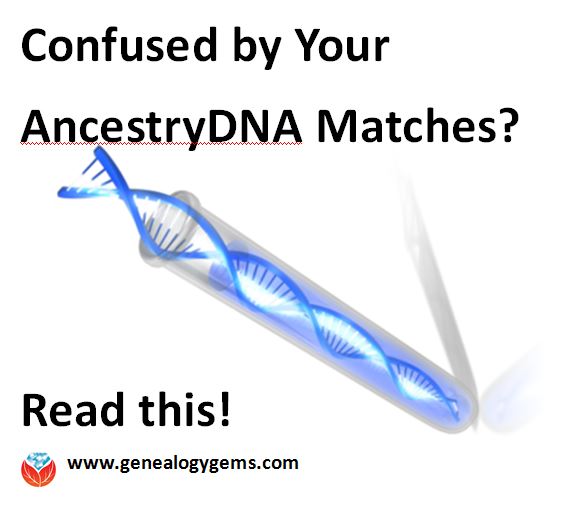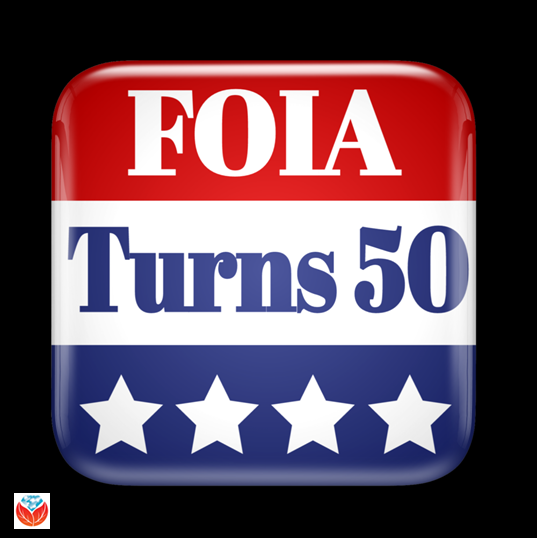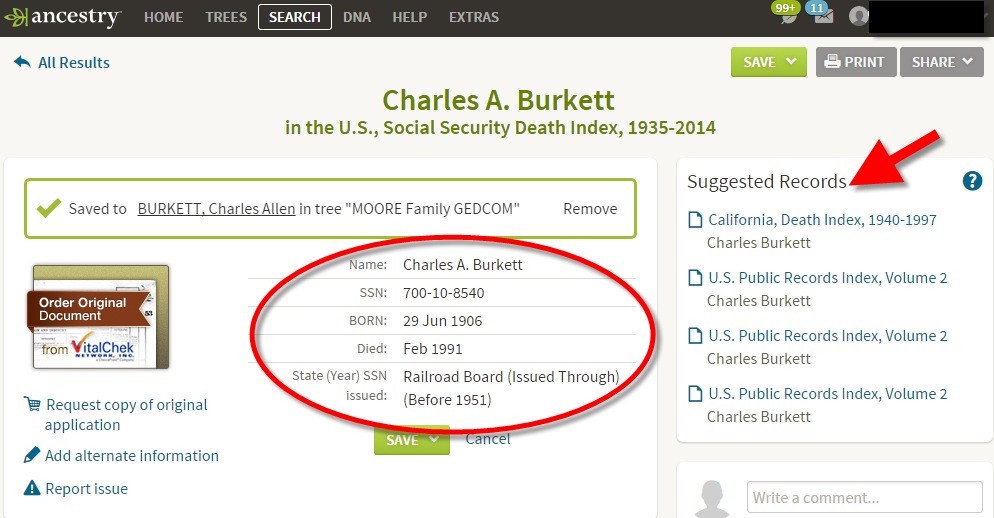by Lisa Cooke | Nov 17, 2015 | 01 What's New, Ancestry, DNA
It’s no surprise to find another DNA post in the #8 spot on our Top 10 genealogy blog post countdown. The topic: understanding your AncestryDNA matches.
In this post, Genealogy Gems resident DNA expert Diahan Southard takes on a confused question sent in by a listener, who didn’t understand why certain people were showing up in her AncestryDNA results.
This post explains SO beautifully a couple of key concepts:
- the difference between your AncestryDNA genetic matches and the DNA Circles/New Ancestry Discoveries that pull from both your genetic results and your family tree; AND
- three reasons someone may show up in your AncestryDNA matches as a New Ancestry Discovery–and which one of those scenarios actually helps your research.
Since running my own autosomal test through AncestryDNA a few months ago, I find myself coming back repeatedly to Diahan’s series of posts to help me  better understand and use those results. I know I’m not alone, since three of Diahan’s DNA posts made our Top 10 this year! (We covered #10 yesterday.)
better understand and use those results. I know I’m not alone, since three of Diahan’s DNA posts made our Top 10 this year! (We covered #10 yesterday.)
Click here to read the above post, and click here to find a list of all DNA-related posts on our genealogy blog.
 If you’ve done your homework and decided that an AncestryDNA test is what should be next for your family history research, thank you for purchasing one by clicking here. Your purchase supports the free Genealogy Gem blog and podcast. (Thank you! YOU are a gem!)
If you’ve done your homework and decided that an AncestryDNA test is what should be next for your family history research, thank you for purchasing one by clicking here. Your purchase supports the free Genealogy Gem blog and podcast. (Thank you! YOU are a gem!)
Disclosure: This article contains affiliate links and Genealogy Gems will be compensated if you make a purchase after clicking on these links (at no additional cost to you). Thank you for supporting Genealogy Gems!
by Lisa Cooke | Jul 4, 2016 | 01 What's New, History, Holidays, Immigration, Research Skills, United States
 Happy July 4th–and Happy 50th to the Freedom of Information Act! Read more about the FOIA and genealogy records we can access because of it.
Happy July 4th–and Happy 50th to the Freedom of Information Act! Read more about the FOIA and genealogy records we can access because of it.
Today we in the United States celebrate our Independence Day with grateful hearts and parades. Well, genealogists with U.S. ancestors have an extra reason for fireworks: today marks 50 years since Congresss signed the Freedom of Information Act into law, and the U.S. became one of the first nations to open its records to the public.
The Freedom of Information Act
The FOIA opens certain kinds of information about the federal government and certain information created by the federal government. It doesn’t apply to everything, including documents that relate to national security, privacy and trade secrets. The FOIA also only applies to documents created by the federal government, not state or local governments.
Since it was passed, the FOIA has continued to be expanded and amended. Over the years, the numbers of FOIA document requests has skyrocketed, too. In the first five years after the FOIA passed, it only resulted in about 500 total requests for information–that’s an average of just 100 per year. Last year alone, there were more than 700,000 requests!
The FOIA and Genealogy
So, of course we have to ask the question: how well do FOIA and genealogy go together? As it turns out, quite well. My favorite FOIA request is for an ancestor’s Social Security application (the SS-5 form). This is the form that generated the assignment of a relative’s Social Security number and was the first step to receiving any Social Security benefits. It’s what the very limited information on the Social Security Death Index comes from, as well as the much-richer (but not comprehensively available) Social Security Applications and Claims database at Ancestry.com. That was released last year and caused a LOT of us to do a serious genealogy happy dance.
But if you want to see everything in that SS-5 application, you should order an image copy of the original (you can now also order a computerized abstract of it, which is cheaper but might not get everything right). Here’s what an SS-5 application looks like:

This one confirms the names of an African-American man’s parents–parents who survived slavery and left few other records of their existence. This man was part of the first generation in his family to legally learn to read and write. His signature is on the record.
You can also access other key 20th-century genealogy records that haven’t made it online yet–and in some cases, haven’t even been sent to the National Archives yet.
These include the following (with links to where to learn more):
There is some fine print on some of these records request procedures, so read carefully what records are there, what you’re allowed to order and how to request it. Happy Independence Day–and Happy FOIA anniversary!
More FOIA and Genealogy Gems
 Try This Now! U.S. Social Security Applications and Claims Index
Try This Now! U.S. Social Security Applications and Claims Index
Search the SSDI for Your Family History
Genealogy Gems Podcast episode 21 about military record requests through FOIA
by Lisa Cooke | Feb 10, 2018 | 01 What's New, African-American
Researching African American roots has unique challenges. This Q&A with expert Angela Walton-Raji can inspire you with tips and success stories. Learn what to ask, what history you should know, how to face the 1870 “wall” and how to explore your ancestor’s freedom...
by Sunny | Jan 27, 2018 | 01 What's New, Ancestry, Memory Lane
Creating free online memorials for your deceased relatives and ancestors is a wonderful way to remember and honor them. Genealogy giant Ancestry.com has created a new portal for posting these free online obituaries. Here’s what Ancestry.com’s “We Remember” tool is all...

 better understand and use those results. I know I’m not alone, since three of Diahan’s DNA posts made our Top 10 this year! (We covered #10 yesterday.)
better understand and use those results. I know I’m not alone, since three of Diahan’s DNA posts made our Top 10 this year! (We covered #10 yesterday.) If you’ve done your homework and decided that an AncestryDNA test is what should be next for your family history research, thank you for purchasing one by clicking here. Your purchase supports the free Genealogy Gem blog and podcast. (Thank you! YOU are a gem!)
If you’ve done your homework and decided that an AncestryDNA test is what should be next for your family history research, thank you for purchasing one by clicking here. Your purchase supports the free Genealogy Gem blog and podcast. (Thank you! YOU are a gem!)
 Happy July 4th–and Happy 50th to the Freedom of Information Act! Read more about the FOIA and genealogy records we can access because of it.
Happy July 4th–and Happy 50th to the Freedom of Information Act! Read more about the FOIA and genealogy records we can access because of it.




